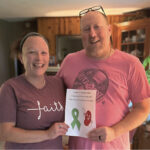
Stacy Teets, Bobbie Ayers, Bonnie Rhoad, Rich Williams, Jennifer Stokes, Steve Wade
As he had done countless times before, Rich Williams, a fit, lean, 62-year-old, joined friends for a long bicycle ride through Lebanon County farm country on the morning of Sept. 4, 2021, unaware of the ticking time bomb in his chest.
He has no memory of what happened next. The cardiac arrest, the bike crash, the ambulance ride to the hospital—it’s all a blur. What he knows is that he is alive today because friends leapt to his aid, called 911, and performed cardiopulmonary resuscitation (CPR) in the crucial minutes before help came.
June 1 to 7 is recognized each year as CPR and AED (automated external defibrillator) week by the American Heart Association, and Williams’ ordeal is a compelling reminder of the unpredictable nature of sudden cardiac arrest and the vital role that ordinary bystanders can play when the unexpected happens.
More than 350,000 people suffer sudden cardiac arrest outside of the hospital each year, and about 90% die, according to the Centers for Disease Control and Prevention (CDC). Nearly 80% of sudden cardiac arrests occur at home or in a nursing home setting, while about 21% occur at work and in other public areas. Warning signs are rare.
“I heard someone holler, ‘Rich went down,’” said fellow rider Bobbie Ayers, a registered nurse and clinical vendor consultant at Capital Blue Cross. That triggered a textbook emergency response.
Someone called 911. Ayers checked for Williams’ pulse while Jennifer Stokes, a nurse at Penn State Milton S. Hershey Medical Center, began rapid chest compressions to preserve blood flow to the brain.
Paramedics arrived on the scene within about 12 minutes, restarted Williams’ heart with one jolt of electricity from their automated external defibrillator (AED), and sped him off to Good Samaritan Hospital in Lebanon.
While Ayers and Stokes are well informed on CPR techniques, the CDC urges bystanders who witness sudden cardiac arrest to help even if they have no such training:
- Call 911.
- Start CPR chest compressions. Push down hard and fast in the center of the chest with about 100 to 120 pushes per minute. The American Heart Association recommends pushing to the beat of songs like “Stayin Alive” by the Bee Gees or “I Will Survive” by Gloria Gaynor.
- Use enough force to push the chest down about two inches.
- If in a high-traffic public building or arena, ask available bystanders to try to locate an AED while you continue chest compressions. AEDs are increasingly common in public places.
- Continue CPR chest compressions until medical help arrives.
Studies show the chance of survival can double or triple for a person who receives CPR in the minutes before medical help arrives, according to the CDC.
“This could happen anywhere,” said Ayers. “Just as an innocent bystander you could save somebody’s life and allow them to get another chance.”
On Dec. 4, three months to the day after he got another chance, and nearly three months after surgeons performed quintuple bypass surgery to restore normal function to his heart, Williams saddled up for a 27-mile ride through farm country.
Blood now flows freely through Williams’ surgically repaired heart. “I’m feeling better than I have in years,” he said. “It’s like night and day.”
“There is no way to express the gratitude I have,” he added. “I feel that encouraging people to learn about CPR is really a civic duty of mine at this point. You just don’t know when somebody is going to need help.”
For more information about Capital Blue Cross, visit www.capbluecross.com.
This column is sponsored by Capital Blue Cross.
If you like what we do, please support our work. Become a Friend of TheBurg!





